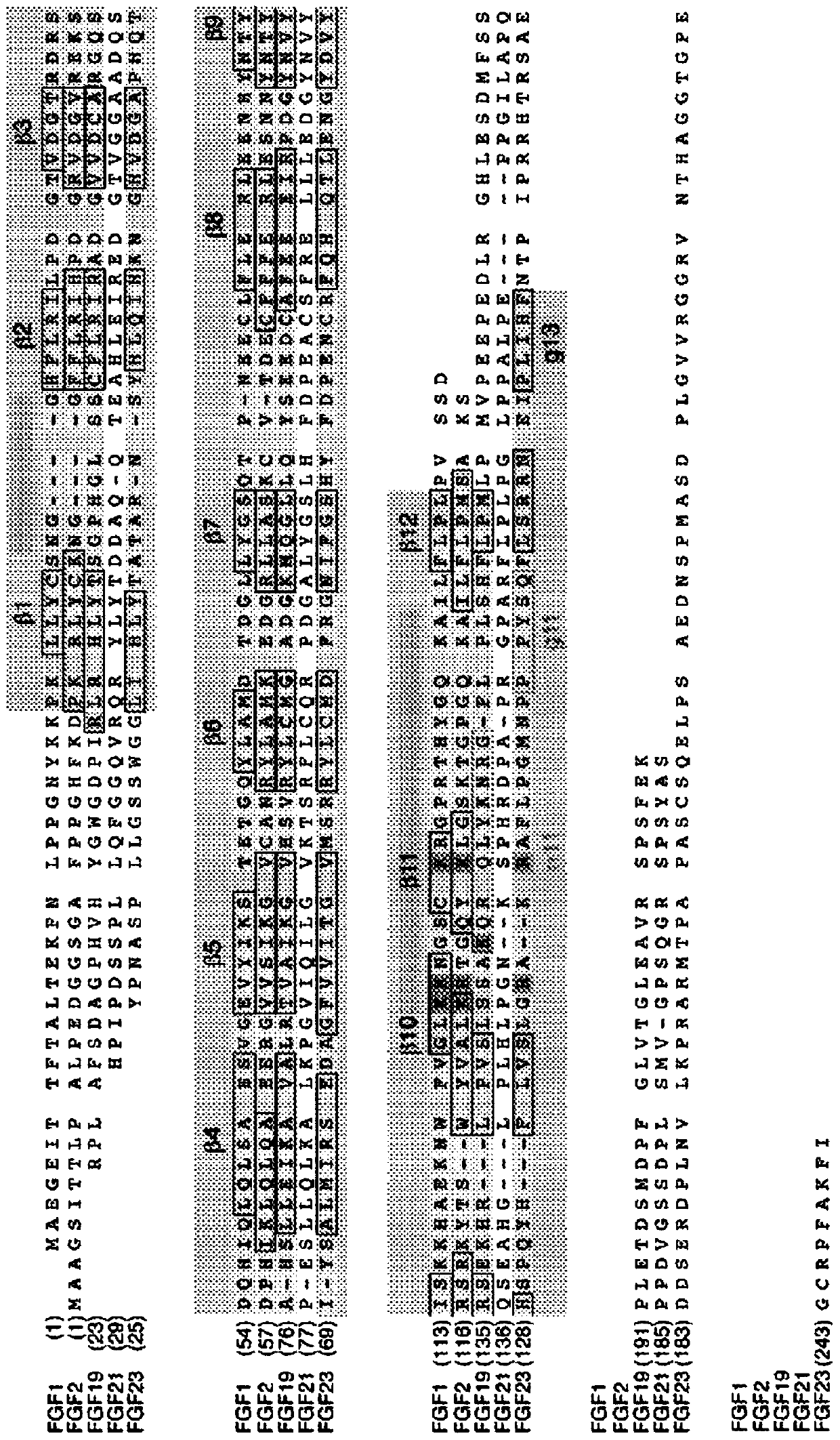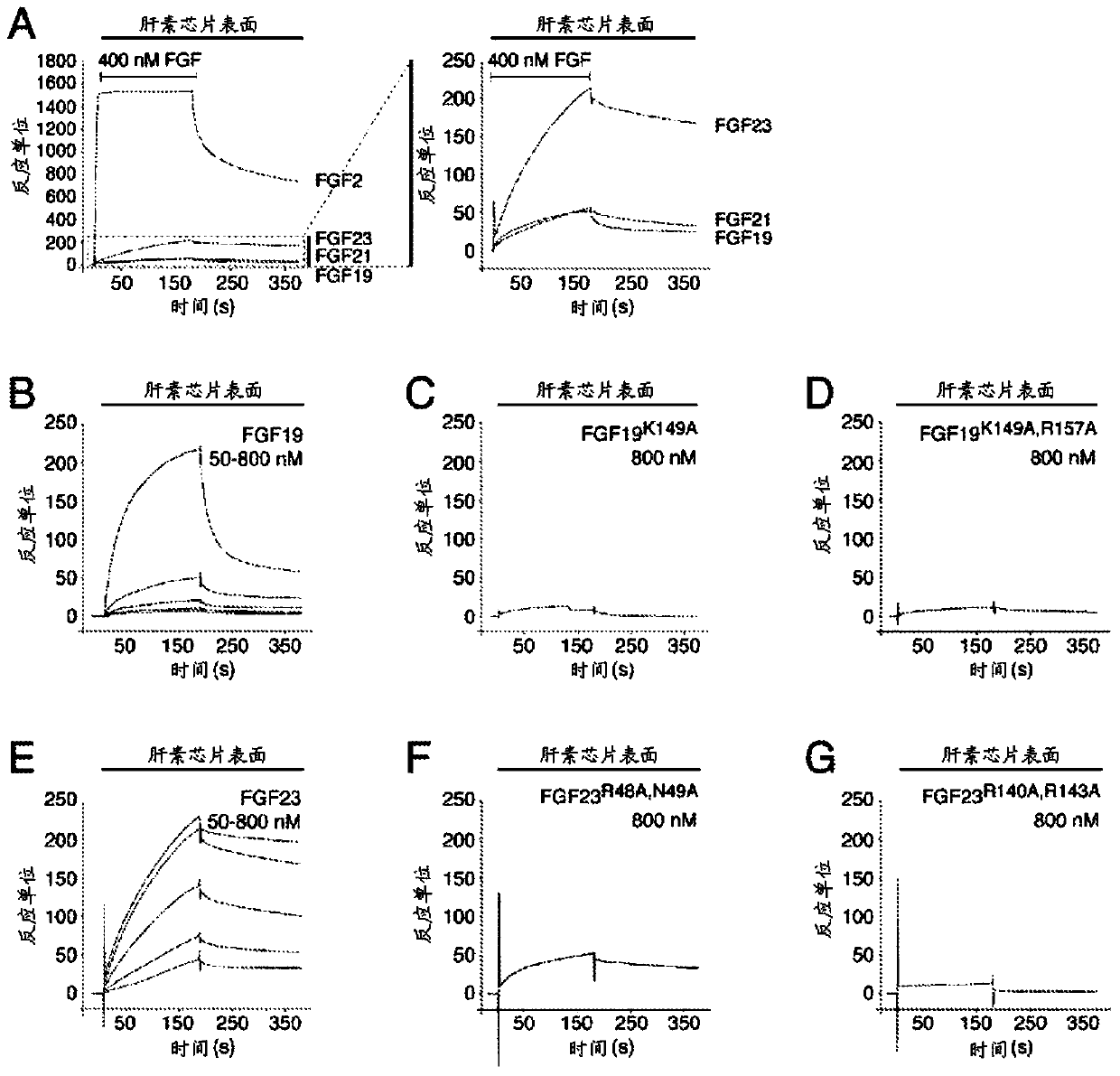Chimeric fibroblast growth factor 21 proteins and methods of use
A fibroblast, chimeric protein technology, applied in the direction of fibroblast growth factor, growth factor/inducing factor, peptide/protein component, etc., can solve the problem of thiazoline dione losing popularity and so on
- Summary
- Abstract
- Description
- Claims
- Application Information
AI Technical Summary
Problems solved by technology
Method used
Image
Examples
Embodiment 1-F
[0254] Purification of Example 1-FGF, FGFR and Klotho Proteins
[0255] In vitro refolding of human FGF19 (SEQ ID NO:337) (R23 to K216), human FGF21 (SEQ ID NO:233) (H29 to S209; Figure 5A ) and human FGF23 (SEQ ID NO:351 ) from bacterial inclusion bodies (Y25 to I251; FIG. 5A ) N-terminal hexahistidine-tagged mature form by published protocols (Ibrahimi et al., Hum. Mol. Genet. 13:2313-2324 (2004); Plotnikov et al., Cell 101 : 413-424 (2000), which is hereby incorporated by reference in its entirety) to purify it. The amino acid sequence (SEQ ID NO:351) of human FGF23 (GenBank Accession No. AAG09917, which is hereby incorporated by reference in its entirety) is as follows:
[0256]
[0257] HS-binding site mutants of FGF19 (K149A) and FGF23 (R140A / R143A) were purified from bacterial inclusion bodies by a similar protocol to the wild-type proteins. To minimize proteolysis of FGF23 wild-type and mutant proteins, glutamine was used to replace the proteolytic cleavage site ...
Embodiment 2
[0259] Example 2 - Analysis of the Interaction of FGF-Heparin and FGF-FGFR-α / βKlotho Using Surface Plasmon Resonance Spectroscopy
[0260] Surface plasmon resonance (SPR) experiments were performed on a Biacore 2000 instrument (Biacore AB), at 25°C in HBS-EP buffer (10mM HEPES-NaOH, pH 7.4, 150mM NaCl, 3mM EDTA, 0.005% (v / v) The interaction was studied in polysorbate 20). To study endocrine FGF-heparin interactions, heparin chips were prepared by immobilizing biotinylated heparin (Sigma-Aldrich) on the flow channels of research-grade streptavidin chips (Biacore AB). The coupling density is ~5 fmol mm -2 the runner. To measure the binding of the chimeric FGF2 protein to heparin, biotinylated heparin was coupled to a streptavidin chip at a density as low as about 1 / 4 as judged based on the binding response obtained for FGF1. To study the FGF-FGFR-α / βKlotho interaction, FGF chips were prepared by covalently coupling FGF proteins via their free amino groups to the flow channel ...
Embodiment 3
[0266] Example 3 - Analysis of Phosphorylation of FRS2α and 44 / 42 MAP Kinases in Hepatoma and Epithelial Cell Lines
[0267] To examine FGF19 K149A and FGF23 R140A / R143A Whether mutants can activate FGFR in an α / βK1 otho-dependent manner, induction of tyrosine phosphorylation of FGFR substrate 2α (FRS2α) and downstream activation of the MAP kinase cascade were used as readouts for FGFR activation. Subconfluent cells of the H4II E rat hepatoma cell line (which endogenously express βKlotho (Kurosu et al., J. Biol. Chem. 282:26687-26695 (2007), which is hereby incorporated by reference in its entirety) ) serum starvation for 16h, followed by FGF19 K149A Mutant or wild-type FGF19 (0.2ng ml -1 to 2.0 μg ml -1 ) stimulation for 10 min. Similarly, with FGF23 R140A / R143A Mutant or wild-type FGF23 (0.1 to 100ng ml -1 ) treatment of subconfluent cells of the HEK293 cell line ectopically expressing the transmembrane isoform of murine αKlotho (Kurosu et al., J. Biol. Chem. 281:6120...
PUM
 Login to View More
Login to View More Abstract
Description
Claims
Application Information
 Login to View More
Login to View More - Generate Ideas
- Intellectual Property
- Life Sciences
- Materials
- Tech Scout
- Unparalleled Data Quality
- Higher Quality Content
- 60% Fewer Hallucinations
Browse by: Latest US Patents, China's latest patents, Technical Efficacy Thesaurus, Application Domain, Technology Topic, Popular Technical Reports.
© 2025 PatSnap. All rights reserved.Legal|Privacy policy|Modern Slavery Act Transparency Statement|Sitemap|About US| Contact US: help@patsnap.com



